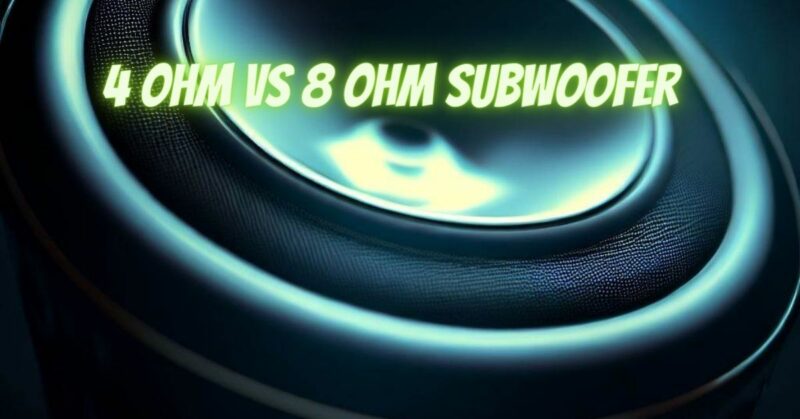In the realm of low-frequency audio reproduction, subwoofers take center stage, delivering powerful bass that can be felt as much as it is heard. When choosing a subwoofer, the decision between 4 ohm and 8 ohm options is a crucial one that can significantly impact the depth, clarity, and impact of your bass reproduction. In this article, we’ll delve into the intricacies of 4 ohm and 8 ohm subwoofers, helping you understand the nuances of each option and how they influence your subwoofer experience.
Understanding Subwoofer Impedance
Subwoofer impedance, measured in ohms (Ω), refers to the resistance that the subwoofer’s voice coil presents to the flow of electrical current. The choice of subwoofer impedance affects various aspects of its performance, including power handling, amplifier compatibility, and overall sound quality.
Comparing 4 Ohm and 8 Ohm Subwoofers
Let’s explore how 4 ohm and 8 ohm subwoofers differ and how they can impact your bass experience:
- Power Handling and Amplifier Compatibility:
- 4 Ohm Subwoofers: Generally, 4 ohm subwoofers can handle more power compared to 8 ohm subwoofers of similar construction. This increased power handling capacity allows for greater bass output and potential headroom.
- 8 Ohm Subwoofers: While 8 ohm subwoofers might have slightly lower power handling, they can still deliver substantial bass impact. They are often more compatible with a wider range of amplifiers without risking power mismatch.
- Efficiency and Output:
- 4 Ohm Subwoofers: Due to their lower impedance, 4 ohm subwoofers can draw more power from the amplifier and potentially produce louder bass output. This can be advantageous for enthusiasts seeking maximum bass impact.
- 8 Ohm Subwoofers: 8 ohm subwoofers can offer efficient bass reproduction while maintaining compatibility with amplifiers that are designed for 8 ohm loads. They can provide balanced and controlled bass response.
- Bass Extension:
- 4 Ohm Subwoofers: Lower impedance subwoofers often have the potential to achieve slightly deeper bass extension due to the increased power draw from the amplifier.
- 8 Ohm Subwoofers: 8 ohm subwoofers can also achieve impressive bass extension, providing impactful low-frequency reproduction that can enhance your audio experience.
- Subwoofer Enclosure Design:
- 4 Ohm Subwoofers: Subwoofers with lower impedance can interact differently with the subwoofer enclosure, potentially resulting in distinct bass characteristics.
- 8 Ohm Subwoofers: 8 ohm subwoofers can offer a balanced and controlled interaction with the subwoofer enclosure, contributing to accurate and well-defined bass reproduction.
Choosing the Right Subwoofer Impedance
Selecting between 4 ohm and 8 ohm subwoofers depends on your listening goals, equipment compatibility, and bass preferences:
- Bass Impact: If you crave maximum bass impact and output, 4 ohm subwoofers can deliver the sheer power you desire.
- Amplifier Compatibility: If you’re using an amplifier optimized for 8 ohm loads, 8 ohm subwoofers ensure proper power matching and compatibility.
- Bass Accuracy: If you value a controlled and accurate bass response, 8 ohm subwoofers might provide the precision you seek.
The choice between 4 ohm and 8 ohm subwoofers involves a careful consideration of your bass preferences, equipment compatibility, and amplifier capabilities. Both impedance options have their strengths, and the optimal choice depends on your specific listening environment and sonic goals. By understanding the nuances of subwoofer impedance and its impact on bass reproduction, you can make an informed decision that elevates your audio experience, ensuring that your subwoofer delivers deep, impactful bass that resonates with precision and power.


